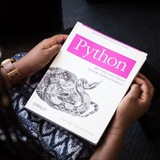Python Code to remove Image Background
—————————————————————-
—————————————————————-
from rembg import remove
from PIL import Image
image_path = 'Image Name' ## ---> Change to Image name
output_image = 'ImageNew' ## ---> Change to new name your image
input = Image.open(image_path)
output = remove(input)
output.save(output_image)👍7
Python code To download from Youtube ⚙
from pytube import YouTube
# Enter the YouTube video URL
url = "https://www.youtube.com/watch?v=dQw4w9W"
# Create a YouTube object with the URL
yt = YouTube(url)
# Select the highest resolution video
video = yt.streams.get_highest_resolution()
# Set the output directory and filename
output_dir = "/storage/emulated/0/Documents/"
filename = yt.title+".mp4"
# Download the video
video.download(output_dir, filename)
print(f"Download complete: {filename}")👍9❤4
Functions are fundamental in 𝗣𝘆𝘁𝗵𝗼𝗻, reusable blocks of code that streamline our work. Whether you're a beginner or an experienced coder, understanding Normal Functions vs. Lambda Functions can level up your coding efficiency.
Let's break it down:
🔹 𝗡𝗼𝗿𝗺𝗮𝗹 𝗙𝘂𝗻𝗰𝘁𝗶𝗼𝗻
With a name, body, and return statement, this function is ideal for tasks that require multiple lines of code or complex logic.
🔹 𝗟𝗮𝗺𝗯𝗱𝗮 𝗙𝘂𝗻𝗰𝘁𝗶𝗼𝗻
Need a quick, single-use function? Lambda is your friend! It’s anonymous and perfect for concise operations.
While Normal Functions are great for more extensive operations, Lambda Functions are excellent for small, single-use operations where you need simplicity.
Choose the function type that best fits your task’s complexity!
Let's break it down:
🔹 𝗡𝗼𝗿𝗺𝗮𝗹 𝗙𝘂𝗻𝗰𝘁𝗶𝗼𝗻
With a name, body, and return statement, this function is ideal for tasks that require multiple lines of code or complex logic.
🔹 𝗟𝗮𝗺𝗯𝗱𝗮 𝗙𝘂𝗻𝗰𝘁𝗶𝗼𝗻
Need a quick, single-use function? Lambda is your friend! It’s anonymous and perfect for concise operations.
While Normal Functions are great for more extensive operations, Lambda Functions are excellent for small, single-use operations where you need simplicity.
Choose the function type that best fits your task’s complexity!
👍7
Python for Scientific Computing Roadmap
Stage 1 – Learn Python (Syntax, OOP)
Stage 2 – Use NumPy and SciPy for Mathematical Computing
Stage 3 – Work with Matplotlib for Data Visualization
Stage 4 – Statistical Analysis (Pandas, Statsmodels)
Stage 5 – Use SymPy for Symbolic Mathematics
Stage 6 – Simulate Models (ODE, PDE)
Stage 7 – Learn Jupyter for Scientific Workflows
Stage 8 – Perform Optimization and Numerical Solvers
🏆 – Python Scientific Developer
Stage 1 – Learn Python (Syntax, OOP)
Stage 2 – Use NumPy and SciPy for Mathematical Computing
Stage 3 – Work with Matplotlib for Data Visualization
Stage 4 – Statistical Analysis (Pandas, Statsmodels)
Stage 5 – Use SymPy for Symbolic Mathematics
Stage 6 – Simulate Models (ODE, PDE)
Stage 7 – Learn Jupyter for Scientific Workflows
Stage 8 – Perform Optimization and Numerical Solvers
🏆 – Python Scientific Developer
👍11
Practice Exercises
Exercise 1: Word Count
Exercise 2: File Copying
Exercise 3: Reverse Content
Exercise 4: Binary File Handling
Exercise 5: Character Frequency
Exercise 1: Word Count
Write a Python program to count the number of words in a text file.
Exercise 2: File Copying
Write a Python program that copies the contents of one file into another file.
Exercise 3: Reverse Content
Write a Python program that reads the content of a file and writes it to a new file in reverse order
Exercise 4: Binary File Handling
Write a Python program that opens a binary file (such as an image) and creates a copy of it.
Exercise 5: Character Frequency
Write a Python program that reads a text file and counts the frequency of each character in the file.
👍13❤4🔥4
